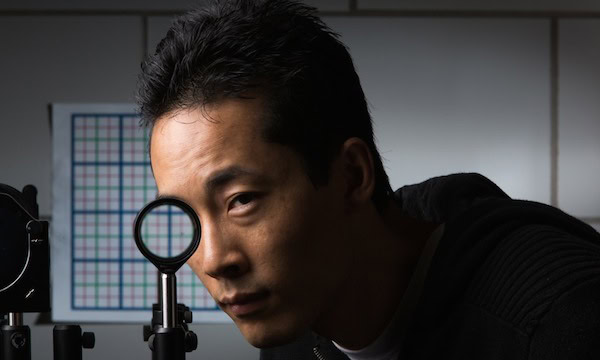
[Image above] Doctoral student Joseph Choi helped develop a multidirectional `perfect paraxial’ invisibility cloak using just four simple optical lenses. Credit: University of Rochester
Harry Potter fans, rejoice—an invisibility cloak is closer than ever to reality.
Scientists at the University of Rochester have devised a simple cloaking device that, although not quite as perfect as the fictional wizard’s cape, does make significant improvements over existing real-world cloaks.
The device uses just four different optical lenses, of particular focal lengths and arranged in a specific configuration, to effectively conceal what’s behind the contraption.

From a continuous range of viewing angles, the hand remains cloaked, and the grids seen through the device match the background on the wall (about 2 m away), in color, spacing, shifts, and magnification. Credit: J. Adam Fenster; University of Rochester
Because the device solely relies on lenses, it’s much cheaper than other more technically sophisticated devices that have been proposed.
“This is the first device that we know of that can do three-dimensional, continuously multidirectional cloaking, which works for transmitting rays in the visible spectrum,” says Joseph Choi, researcher and PhD student at Rochester’s Institute of Optics, in a Rochester press release. Choi worked on the project alongside physics professor John Howell.
See the light- and mind-bending device in action in this short video below.

Credit: University of Rochester; YouTube
Unlike previous devices, the lens-based contraption hides an object from multiple viewing angles and also doesn’t distort the background—a must for not giving away the cloak’s presence.
“The Rochester Cloak can be scaled up as large as the size of the lenses, allowing fairly large objects to be cloaked. And, unlike some other devices, it’s broadband so it works for the whole visible spectrum of light, rather than only for specific frequencies,” states the press release.
The cloak still isn’t quite Potter quality, however. “This cloak bends light and sends it through the center of the device, so the on-axis region cannot be blocked or cloaked,” Choi adds in the release.
But, although it’s not perfect, that doesn’t mean the device isn’t without use. As explained in the release, it could still be useful for surgeons in the operating room to see through the hands, or for truck drivers to see blind spots.
Head over here to get the specifics to build your own device. The paper, submitted to Optics Express, is available here.

Setup of the multidirectional cloak as seen from the side. Laser shows the paths that light rays travel through the system, showing regions that can be used for cloaking an object. Credit: J. Adam Fenster; University of Rochester
Author
April Gocha
CTT Categories
- Glass
- Material Innovations
- Optics


